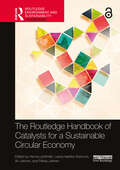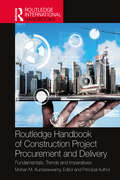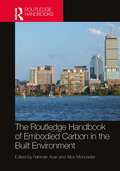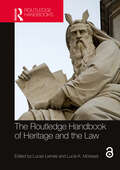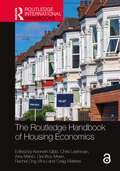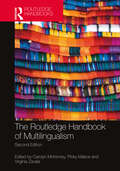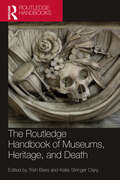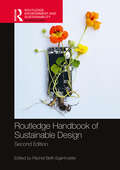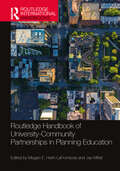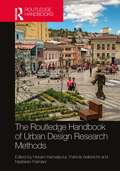- Table View
- List View
The Routledge Handbook of Catalysts for a Sustainable Circular Economy (Routledge Environment and Sustainability Handbooks)
by Hanna Lehtimäki Leena Aarikka-Stenroos Ari Jokinen Pekka JokinenThis groundbreaking handbook leads the way in accelerating the transition to a sustainable circular economy by introducing the concept of a catalyst as a positive and enhancing driving force for sustainability. Catalysts create and maintain favourable conditions for complex systemic sustainability transition changes, and a discussion and understanding of catalysts is required to move from a linear economy to a sustainable and circular economy.With contributions from leading experts from around the globe, this volume presents theoretical insights, contextualised case studies, and participatory methodologies, which identify different catalysts, including technology, innovation, business models, management and organisation, regulation, sustainability policy, product design, and culture. The authors then show how these catalysts accelerate sustainability transitions. As a unique value to the reader, the book brings together public policy and private business perspectives to address the circular economy as a systemic change. Its theoretical and practical perspectives are coupled with real-world case studies from Finland, Italy, China, India, Nigeria, and others to provide tangible insights on catalysing the circular economy across organisational, hierarchical, and disciplinary boundaries.With its broad interdisciplinary and geographically diverse scope, this handbook will be a valuable tool for researchers, academics, and policy-makers in the fields of circular economy, sustainability transitions, environmental studies, business, and the social sciences more broadly.The Open Access version of this book, available at http://www.taylorfrancis.com, has been made available under a Creative Commons Attribution-Non Commercial-No Derivatives (CC-BY-NC-ND) 4.0 license.
Routledge Handbook of Construction Project Procurement and Delivery: Fundamentals, Trends and Imperatives
by Mohan M. KumaraswamyThis Handbook provides the knowledge needed to design and deploy proactive construction project procurement and delivery systems based on essentials while addressing emerging construction industry imperatives in order to boost overall performance.Section 1 of the Handbook provides an overview, while Section 2 provides the fundamentals with fresh insights into the building blocks and trends in performance-linked procurement and delivery, including procurement strategies and commercial priorities, project briefs and management plans, design management, stakeholder management, risk management, ethics and professionalism, team building, information and knowledge management, digital aids, conflict, claims and dispute management, collaborative contracting, relationship-based teamworking and linking to built asset management.Section 3 explores and expands on specific trends, including sub-contractor selection, Building Information Modelling (BIM) in project cost management; off-site and modern methods of construction; 4IR/5IR technologies; and constructing for the circular economy, supply chain resilience and social value imperatives in this domain.While other books describe standard processes or focus on specific strategies such as design and build, target cost contracting or integrated project delivery, this Handbook presents the fundamentals of such processes and protocols together with invited specialist insights into growing trends and imperatives in holistic procurement and delivery. Those who could benefit from this Handbook include academics, researchers, postgraduate students, policy makers and administrators, managers in both public and private sectors involved with planning and overseeing construction project procurement and/or delivery and undergraduates looking for a balanced introduction and useful insights into what is critical to the success of construction projects, organisations and the industry itself.
Routledge Handbook of Construction Project Procurement and Delivery: Fundamentals, Trends and Imperatives
This Handbook provides the knowledge needed to design and deploy proactive construction project procurement and delivery systems based on essentials while addressing emerging construction industry imperatives in order to boost overall performance.Section 1 of the Handbook provides an overview, while Section 2 provides the fundamentals with fresh insights into the building blocks and trends in performance-linked procurement and delivery, including procurement strategies and commercial priorities, project briefs and management plans, design management, stakeholder management, risk management, ethics and professionalism, team building, information and knowledge management, digital aids, conflict, claims and dispute management, collaborative contracting, relationship-based teamworking and linking to built asset management.Section 3 explores and expands on specific trends, including sub-contractor selection, Building Information Modelling (BIM) in project cost management; off-site and modern methods of construction; 4IR/5IR technologies; and constructing for the circular economy, supply chain resilience and social value imperatives in this domain.While other books describe standard processes or focus on specific strategies such as design and build, target cost contracting or integrated project delivery, this Handbook presents the fundamentals of such processes and protocols together with invited specialist insights into growing trends and imperatives in holistic procurement and delivery. Those who could benefit from this Handbook include academics, researchers, postgraduate students, policy makers and administrators, managers in both public and private sectors involved with planning and overseeing construction project procurement and/or delivery and undergraduates looking for a balanced introduction and useful insights into what is critical to the success of construction projects, organisations and the industry itself.
The Routledge Handbook of Embodied Carbon in the Built Environment
This handbook explores the critically important topic of embodied carbon, providing advanced insights that focus on measuring and reducing embodied carbon from across the built environment, including buildings, urban areas and cities, and construction materials and components. Split into five distinct sections, international experts, researchers, and professionals present the recent developments in the field of embodied carbon from various perspectives and at different scales of material, building, and city. Following an introduction to the embodied carbon question, the chapters in Section 1 then cover the key debates around issues such as the politics of embodied carbon, links between embodied carbon and thermal mass, and the misuse of carbon offsets. Section 2 reviews the embodied carbon policies in a selected number of countries. Sections 3, 4, and 5 approach the topic of embodied carbon from urban-, building-, and material-scale perspectives, respectively, and use case studies to demonstrate estimation techniques and present opportunities and challenges in embodied carbon mitigation. This will be important reading for upper-level students and researchers in Architecture, Urban Planning, Engineering, and Construction disciplines. Presenting case studies of embodied carbon assessment, this book will also help practicing architects, engineers, and urban planners understand embodied carbon estimation techniques and different mitigation strategies.
The Routledge Handbook of Embodied Carbon in the Built Environment
by Rahman Azari Alice MoncasterThis handbook explores the critically important topic of embodied carbon, providing advanced insights that focus on measuring and reducing embodied carbon from across the built environment, including buildings, urban areas and cities, and construction materials and components. Split into five distinct sections, international experts, researchers, and professionals present the recent developments in the field of embodied carbon from various perspectives and at different scales of material, building, and city. Following an introduction to the embodied carbon question, the chapters in Section 1 then cover the key debates around issues such as the politics of embodied carbon, links between embodied carbon and thermal mass, and the misuse of carbon offsets. Section 2 reviews the embodied carbon policies in a selected number of countries. Sections 3, 4, and 5 approach the topic of embodied carbon from urban-, building-, and material-scale perspectives, respectively, and use case studies to demonstrate estimation techniques and present opportunities and challenges in embodied carbon mitigation. This will be important reading for upper-level students and researchers in Architecture, Urban Planning, Engineering, and Construction disciplines. Presenting case studies of embodied carbon assessment, this book will also help practicing architects, engineers, and urban planners understand embodied carbon estimation techniques and different mitigation strategies.
The Routledge Handbook of Heritage and the Law (Routledge Handbooks on Museums, Galleries and Heritage)
The Routledge Handbook of Heritage and the Law sheds light on the relationship between the two fields and analyses how the law shapes heritage and heritage practice in both expected and unexpected ways.Including contributions from 41 authors working across a range of jurisdictions, the volume analyses the law as a transnational phenomenon and uses international and comparative legal methodologies to distil lessons for broad application. Demonstrating that the law is fundamentally a language of power and contestation, the Handbook shows how this impacts our views of heritage. It also shows that, to understand the ways in which the law impacts key aspects of heritage practice, it is important to tap into the possibilities of heritage as points of convergence of identity, struggles over resources, and the distribution of power. Framing heritage as a driver for legal engagement rather than a passive regulatory object, the book first reviews the legal fields or mechanisms that can shape action in the heritage field, then questions how these enable authority and give power to those who seize heritage, and finally envisions how the discussion between heritage and the law can lay new grounds in both those fields. Lifting the mists that often render the law opaque in heritage studies, the Handbook showcases the law as a medium through which the culture and the power of heritage are expressed and might be shared.The Routledge Handbook of Heritage and the Law presents a view of the law that is aimed at those who wish to reflect on how law has changed, or could change, what heritage is and how it can support social, cultural, local, or other development. It will be of interest to scholars, students, policymakers, and practitioners working in the areas of museum studies, heritage studies, and urban studies, as well as in cultural intervention and planning.Chapter 8 of this book is freely available as a downloadable Open Access PDF at http://www.taylorfrancis.com under a Creative Commons [Attribution-Non Commercial-No Derivatives (CC-BY-NC-ND)] 4.0 license
The Routledge Handbook of Heritage and the Law (Routledge Handbooks on Museums, Galleries and Heritage)
by Lucas Lixinski Lucie K. MorissetThe Routledge Handbook of Heritage and the Law sheds light on the relationship between the two fields and analyses how the law shapes heritage and heritage practice in both expected and unexpected ways.Including contributions from 41 authors working across a range of jurisdictions, the volume analyses the law as a transnational phenomenon and uses international and comparative legal methodologies to distil lessons for broad application. Demonstrating that the law is fundamentally a language of power and contestation, the Handbook shows how this impacts our views of heritage. It also shows that, to understand the ways in which the law impacts key aspects of heritage practice, it is important to tap into the possibilities of heritage as points of convergence of identity, struggles over resources, and the distribution of power. Framing heritage as a driver for legal engagement rather than a passive regulatory object, the book first reviews the legal fields or mechanisms that can shape action in the heritage field, then questions how these enable authority and give power to those who seize heritage, and finally envisions how the discussion between heritage and the law can lay new grounds in both those fields. Lifting the mists that often render the law opaque in heritage studies, the Handbook showcases the law as a medium through which the culture and the power of heritage are expressed and might be shared.The Routledge Handbook of Heritage and the Law presents a view of the law that is aimed at those who wish to reflect on how law has changed, or could change, what heritage is and how it can support social, cultural, local, or other development. It will be of interest to scholars, students, policymakers, and practitioners working in the areas of museum studies, heritage studies, and urban studies, as well as in cultural intervention and planning.Chapter 8 of this book is freely available as a downloadable Open Access PDF at http://www.taylorfrancis.com under a Creative Commons [Attribution-Non Commercial-No Derivatives (CC-BY-NC-ND)] 4.0 license
Routledge Handbook of High-Performance Workplaces (Transdisciplinary Workplace Research and Management)
by Christhina Candido Iva Durakovic Samin MarzbanThis timely book focuses on an overview of the fundamentals behind high-performance workplaces underpinning occupants’ satisfaction, health, and productivity. To this end, it covers human, environmental, and organisational aspects proven to be of great relevance to the design of high-performance workplaces. Perhaps most significantly it looks at these characteristics both before and after the start of the COVID-19 pandemic. From the exodus from private offices to the rise of open-plan workplaces, where, how and when people work was changing rapidly pre-COVID. Post-COVID, pandemic-imposed restrictions banished workers from offices into their homes fast, leaving organisation scrambling to keep workers functioning away from HQ. After the immediate shockwaves set by the pandemic, workers and organisations have had the time to learn about positives and negative aspects of remote working with the vast majority now questioning the need to go back to HQ and the purpose of offices. In this book, the contributors share and discuss lessons learned from research conducted in workplaces pre- and post-2020 with a view of providing a clear picture about what high-performance workplaces are about, including the key drivers behind workers’ satisfaction, health, and productivity. This handbook builds on a programme of applied research conducted in workplaces led by the editors over the last decade which is aimed at understanding the synergies between the design, performance, and experience of spaces. It examines ergonomics, biophilic design, acoustics, indoor air quality, thermal comfort, diversity, leadership, psychological safety, culture, and much more. Research findings are presented side-by-side with case studies selected from the research database led by the editors. Industry experts add to the academic voice, reinforcing the authenticity of this book and its relevance to other stakeholders found outside the academic arena, including the property and design industry, students, government, and the community in general.The Open Access version of this book, available at http://www.taylorfrancis.com, has been made available under a Creative Commons Attribution-Non Commercial-No Derivatives (CC-BY-NC-ND) 4.0 license.
Routledge Handbook of High-Performance Workplaces (Transdisciplinary Workplace Research and Management)
This timely book focuses on an overview of the fundamentals behind high-performance workplaces underpinning occupants’ satisfaction, health, and productivity. To this end, it covers human, environmental, and organisational aspects proven to be of great relevance to the design of high-performance workplaces. Perhaps most significantly it looks at these characteristics both before and after the start of the COVID-19 pandemic. From the exodus from private offices to the rise of open-plan workplaces, where, how and when people work was changing rapidly pre-COVID. Post-COVID, pandemic-imposed restrictions banished workers from offices into their homes fast, leaving organisation scrambling to keep workers functioning away from HQ. After the immediate shockwaves set by the pandemic, workers and organisations have had the time to learn about positives and negative aspects of remote working with the vast majority now questioning the need to go back to HQ and the purpose of offices. In this book, the contributors share and discuss lessons learned from research conducted in workplaces pre- and post-2020 with a view of providing a clear picture about what high-performance workplaces are about, including the key drivers behind workers’ satisfaction, health, and productivity. This handbook builds on a programme of applied research conducted in workplaces led by the editors over the last decade which is aimed at understanding the synergies between the design, performance, and experience of spaces. It examines ergonomics, biophilic design, acoustics, indoor air quality, thermal comfort, diversity, leadership, psychological safety, culture, and much more. Research findings are presented side-by-side with case studies selected from the research database led by the editors. Industry experts add to the academic voice, reinforcing the authenticity of this book and its relevance to other stakeholders found outside the academic arena, including the property and design industry, students, government, and the community in general.The Open Access version of this book, available at http://www.taylorfrancis.com, has been made available under a Creative Commons Attribution-Non Commercial-No Derivatives (CC-BY-NC-ND) 4.0 license.
The Routledge Handbook of Housing Economics (Routledge International Handbooks)
by Kenneth Gibb Chris Leishman Alex Marsh Geoffrey Meen Rachel Ong ViforJ Craig WatkinsThe Routledge Handbook of Housing Economics brings together an international panel of contributors to present a comprehensive overview of this important field within economics. Housing occupies an increasingly central role in modern society, dominating consumer assets and spending, forming an important part of social policy and being a large enough market to impact the macroeconomy. This handbook tackles these themes, along with other critical issues such as intergenerational housing inequality and the efficiency and social justice of housing interventions.This volume is structured in four main parts. It starts with eight chapters in microeconomics and housing. This is followed by two shorter sections on macroeconomics and finance. The final main part of the book is concerned with eight chapters on policy dimensions. While many of the chapters are rooted in mainstream economics and finance applied to housing, there are also chapters stressing institutional, behavioural and political economy orientations, as well as those that explicitly challenge more mainstream accounts. The contributing authors are based in Europe, North America and Australia and all draw in international literature to provide state of the art reviews of their topics.This carefully curated handbook will be essential reading for advanced students, researchers and policy makers in housing economics, urban economics, urban planning, public economics and real estate economics and finance.
The Routledge Handbook of Housing Economics (Routledge International Handbooks)
The Routledge Handbook of Housing Economics brings together an international panel of contributors to present a comprehensive overview of this important field within economics. Housing occupies an increasingly central role in modern society, dominating consumer assets and spending, forming an important part of social policy and being a large enough market to impact the macroeconomy. This handbook tackles these themes, along with other critical issues such as intergenerational housing inequality and the efficiency and social justice of housing interventions.This volume is structured in four main parts. It starts with eight chapters in microeconomics and housing. This is followed by two shorter sections on macroeconomics and finance. The final main part of the book is concerned with eight chapters on policy dimensions. While many of the chapters are rooted in mainstream economics and finance applied to housing, there are also chapters stressing institutional, behavioural and political economy orientations, as well as those that explicitly challenge more mainstream accounts. The contributing authors are based in Europe, North America and Australia and all draw in international literature to provide state of the art reviews of their topics.This carefully curated handbook will be essential reading for advanced students, researchers and policy makers in housing economics, urban economics, urban planning, public economics and real estate economics and finance.
The Routledge Handbook of Multilingualism (Routledge Handbooks in Applied Linguistics)
The Routledge Handbook of Multilingualism provides a comprehensive survey of the field of multilingualism for a global readership and an overview of the research which situates multilingualism in its social, cultural and political context. This fully revised edition not only updates several of the original chapters but introduces many new ones that enrich contemporary debates in the burgeoning field of multilingualism. With a decolonial perspective and including leading new and established contributors from different regions of the globe, the handbook offers a critical overview of the interdisciplinary field of multilingualism, providing a range of central themes, key debates and research sites for a global readership. Chapters address the profound epistemological and ontological challenges and shifts produced since the first edition in 2012. The handbook includes an introduction, five parts with 28 chapters and an afterword. The chapters are structured around sub-themes, such as Coloniality and Multilingualism, Concepts and Theories in Multilingualism, and Multilingualism and Education. This ground-breaking text is a crucial resource for researchers, scholars and postgraduate students interested in multilingualism from areas such as sociolinguistics, applied linguistics, anthropology and education.
The Routledge Handbook of Multilingualism (Routledge Handbooks in Applied Linguistics)
by Carolyn McKinney Pinky Makoe Virginia ZavalaThe Routledge Handbook of Multilingualism provides a comprehensive survey of the field of multilingualism for a global readership and an overview of the research which situates multilingualism in its social, cultural and political context. This fully revised edition not only updates several of the original chapters but introduces many new ones that enrich contemporary debates in the burgeoning field of multilingualism. With a decolonial perspective and including leading new and established contributors from different regions of the globe, the handbook offers a critical overview of the interdisciplinary field of multilingualism, providing a range of central themes, key debates and research sites for a global readership. Chapters address the profound epistemological and ontological challenges and shifts produced since the first edition in 2012. The handbook includes an introduction, five parts with 28 chapters and an afterword. The chapters are structured around sub-themes, such as Coloniality and Multilingualism, Concepts and Theories in Multilingualism, and Multilingualism and Education. This ground-breaking text is a crucial resource for researchers, scholars and postgraduate students interested in multilingualism from areas such as sociolinguistics, applied linguistics, anthropology and education.
The Routledge Handbook of Museums, Heritage, and Death (Routledge Handbooks on Museums, Galleries and Heritage)
by Trish Biers Katie Stringer ClaryThis book provides a comprehensive examination of death, dying, and human remains in museums and heritage sites around the world. Presenting a diverse range of contributions from scholars, practitioners, and artists, the book reminds us that death and the dead body are omnipresent in museum and heritage spaces. Chapters appraise collection practices and their historical context, present global perspectives and potential resolutions, and suggest how death and dying should be presented to the public. Acknowledging that professionals in the galleries, libraries, archives, and museums (GLAM) fields are engaging in vital discussions about repatriation and anti-colonialist narratives, the book includes reflections on a variety of deathscapes that are at the forefront of the debate. Taking a multivocal approach, the handbook provides a foundation for debate as well as a reference for how the dead are treated within the public arena. Most important, perhaps, the book highlights best practices and calls for more ethical frameworks and strategies for collaboration, particularly with descendant communities. The Routledge Handbook of Museums, Heritage, and Death will be useful to all individuals working with, studying, and interested in curation and exhibition at museums and heritage sites around the world. It will be of particular interest to those working in the fields of heritage, museum studies, death studies, archaeology, anthropology, sociology, and history.
The Routledge Handbook of Museums, Heritage, and Death (Routledge Handbooks on Museums, Galleries and Heritage)
by Trish Biers Katie Stringer ClaryThis book provides a comprehensive examination of death, dying, and human remains in museums and heritage sites around the world. Presenting a diverse range of contributions from scholars, practitioners, and artists, the book reminds us that death and the dead body are omnipresent in museum and heritage spaces. Chapters appraise collection practices and their historical context, present global perspectives and potential resolutions, and suggest how death and dying should be presented to the public. Acknowledging that professionals in the galleries, libraries, archives, and museums (GLAM) fields are engaging in vital discussions about repatriation and anti-colonialist narratives, the book includes reflections on a variety of deathscapes that are at the forefront of the debate. Taking a multivocal approach, the handbook provides a foundation for debate as well as a reference for how the dead are treated within the public arena. Most important, perhaps, the book highlights best practices and calls for more ethical frameworks and strategies for collaboration, particularly with descendant communities. The Routledge Handbook of Museums, Heritage, and Death will be useful to all individuals working with, studying, and interested in curation and exhibition at museums and heritage sites around the world. It will be of particular interest to those working in the fields of heritage, museum studies, death studies, archaeology, anthropology, sociology, and history.
Routledge Handbook of Sustainable Design (Routledge Environment and Sustainability Handbooks)
by Rachel Beth EgenhoeferThe Routledge Handbook of Sustainable Design considers the design, not only of artifacts, but of structures, systems, and interactions in the context of sustaining our shared planet. This revised edition introduces new and updated chapters, as well as a new section on pedagogy for sustainable design. With authors from around the world, design is positioned in context with recent crises such as global pandemics, racial reckoning, political unrest, and natural disasters. Just as design is an interdisciplinary field, the climate crisis is deeply tangled in racial justice, gender justice, global health, economics, trade, and more. Divided into six sections, it presents a holistic approach to understanding the many facets of sustainable design: Part 1: Systems and Design Part 2: Complexities of Sustainable Design Part 3: Community Engaged Design for Local and Global Diversity Part 4: Design for Sustainable Behaviors Part 5: Design Futures Part 6: Pedagogy in Design for Sustainability Arguing that design needs to restore, regenerate, and rejuvenate our planet and people, this handbook will be invaluable to researchers, students, and practitioners across all subdisciplines of design, architecture, business, energy management, visual arts, and environmental studies, among others.
Routledge Handbook of Sustainable Design (Routledge Environment and Sustainability Handbooks)
by Rachel Beth EgenhoeferThe Routledge Handbook of Sustainable Design considers the design, not only of artifacts, but of structures, systems, and interactions in the context of sustaining our shared planet. This revised edition introduces new and updated chapters, as well as a new section on pedagogy for sustainable design. With authors from around the world, design is positioned in context with recent crises such as global pandemics, racial reckoning, political unrest, and natural disasters. Just as design is an interdisciplinary field, the climate crisis is deeply tangled in racial justice, gender justice, global health, economics, trade, and more. Divided into six sections, it presents a holistic approach to understanding the many facets of sustainable design: Part 1: Systems and Design Part 2: Complexities of Sustainable Design Part 3: Community Engaged Design for Local and Global Diversity Part 4: Design for Sustainable Behaviors Part 5: Design Futures Part 6: Pedagogy in Design for Sustainability Arguing that design needs to restore, regenerate, and rejuvenate our planet and people, this handbook will be invaluable to researchers, students, and practitioners across all subdisciplines of design, architecture, business, energy management, visual arts, and environmental studies, among others.
Routledge Handbook of University-Community Partnerships in Planning Education (Routledge International Handbooks)
by Heim LaFrombois, Megan E. Jay MittalThis handbook explores two guiding questions – how can university-community partnerships in planning education work, and how can they be transformative? University-community partnerships – often referred to as service-learning or community-engaged teaching and learning – are traditionally based on a collaborative relationship between an academic partner and a community-based partner, in which students from the academic partner work within the community on a project. Transformational approaches to university-community partnerships are approaches that develop and sustain mutually beneficial collaborations where knowledge is co-created and new ways of knowing and doing are discovered. This edited volume examines a variety of university-community partnerships in planning education, from a number of different perspectives, with a focus on transformative models. The authors explore broader theoretical issues, including topics relating to pedagogy, planning theory, and curriculum; along with more practical topics relating to best practices, logistics, institutional support, outcome measures, and the various forms these partnerships can take – all through an array of case studies. The authors, which include academics, professional practitioners, academic practitioners, and students, bring an incredible depth and breadth of knowledge and experience from across the globe – Australia, Canada, Chile, Europe (including Germany, Spain, Slovakia, and Sweden), India, Jamaica, South Korea, and the United States.
Routledge Handbook of University-Community Partnerships in Planning Education (Routledge International Handbooks)
by Megan E. Heim LaFrombois Jay MittalThis handbook explores two guiding questions – how can university-community partnerships in planning education work, and how can they be transformative? University-community partnerships – often referred to as service-learning or community-engaged teaching and learning – are traditionally based on a collaborative relationship between an academic partner and a community-based partner, in which students from the academic partner work within the community on a project. Transformational approaches to university-community partnerships are approaches that develop and sustain mutually beneficial collaborations where knowledge is co-created and new ways of knowing and doing are discovered. This edited volume examines a variety of university-community partnerships in planning education, from a number of different perspectives, with a focus on transformative models. The authors explore broader theoretical issues, including topics relating to pedagogy, planning theory, and curriculum; along with more practical topics relating to best practices, logistics, institutional support, outcome measures, and the various forms these partnerships can take – all through an array of case studies. The authors, which include academics, professional practitioners, academic practitioners, and students, bring an incredible depth and breadth of knowledge and experience from across the globe – Australia, Canada, Chile, Europe (including Germany, Spain, Slovakia, and Sweden), India, Jamaica, South Korea, and the United States.
The Routledge Handbook of Urban Design Research Methods
by Hesam Kamalipour Patricia Aelbrecht Nastaran PeimaniAs an evolving and contested field, urban design has been made, unmade, and remade at the intersections of multiple disciplines and professions. It is now a decisive moment for urban design to reflect on its rigour and relevance. This handbook is an attempt to seize this moment for urban design to further develop its theoretical and methodological knowledge base and engage with the question of "what urban design can be" with a primary focus on its research. This handbook includes contributions from both established and emerging scholars across the global North and global South to provide a more field-specific entry point by introducing a range of topics and lines of inquiry and discussing how they can be explored with a focus on the related research designs and methods. The specific aim, scope, and structure of this handbook are appealing to a range of audiences interested and/or involved in shaping places and public spaces. What makes this book quite distinctive from conventional handbooks on research methods is the way it has been structured in relation to some key research topics and questions in the field of urban design regarding the issues of agency, affordance, place, informality, and performance. In addition to the introduction chapter, this handbook includes 80 contributors and 52 chapters organised into five parts. The commissioned chapters showcase a wide range of topics, research designs, and methods with references to relevant scholarly works on the related topics and methods.
The Routledge Handbook of Urban Design Research Methods
by Hesam Kamalipour Patricia Aelbrecht Nastaran PeimaniAs an evolving and contested field, urban design has been made, unmade, and remade at the intersections of multiple disciplines and professions. It is now a decisive moment for urban design to reflect on its rigour and relevance. This handbook is an attempt to seize this moment for urban design to further develop its theoretical and methodological knowledge base and engage with the question of "what urban design can be" with a primary focus on its research. This handbook includes contributions from both established and emerging scholars across the global North and global South to provide a more field-specific entry point by introducing a range of topics and lines of inquiry and discussing how they can be explored with a focus on the related research designs and methods. The specific aim, scope, and structure of this handbook are appealing to a range of audiences interested and/or involved in shaping places and public spaces. What makes this book quite distinctive from conventional handbooks on research methods is the way it has been structured in relation to some key research topics and questions in the field of urban design regarding the issues of agency, affordance, place, informality, and performance. In addition to the introduction chapter, this handbook includes 80 contributors and 52 chapters organised into five parts. The commissioned chapters showcase a wide range of topics, research designs, and methods with references to relevant scholarly works on the related topics and methods.
Routledge Handbook on Arab Cinema
Building on a growing body of literature, this Handbook provides an up-to-date and authoritative survey of Arab cinema.The collection includes contributions from academics and filmmakers from across the Arab region, Europe, and North America, and fills a gap in media studies by examining the entire Arab region, rather than focusing on one country or theme. The Handbook also sheds light on the heterogeneity of Arab filmmaking not only within the Arab region, but also globally, within diasporic communities. It is split into six parts: Part 1 provides an overview of each sub-region in the Arab world, including a chapter on Arab animation films. Parts 2, 3, and 4 address topical themes, encompassing the representation of gender, religion, and identity politics in Arab cinema. Part 5 discusses the theme of diaspora and Part 6 concludes the volume with reflective essays penned by selected diasporic filmmakers. This book is an essential reference for Arab media and cinema scholars, students, and professional filmmakers. With case studies from across the Arab region, it's also a valuable resource for anyone interested in film and media, global cinema, and the Middle East generally.
Routledge Handbook on Arab Cinema
by Noha MellorBuilding on a growing body of literature, this Handbook provides an up-to-date and authoritative survey of Arab cinema.The collection includes contributions from academics and filmmakers from across the Arab region, Europe, and North America, and fills a gap in media studies by examining the entire Arab region, rather than focusing on one country or theme. The Handbook also sheds light on the heterogeneity of Arab filmmaking not only within the Arab region, but also globally, within diasporic communities. It is split into six parts: Part 1 provides an overview of each sub-region in the Arab world, including a chapter on Arab animation films. Parts 2, 3, and 4 address topical themes, encompassing the representation of gender, religion, and identity politics in Arab cinema. Part 5 discusses the theme of diaspora and Part 6 concludes the volume with reflective essays penned by selected diasporic filmmakers. This book is an essential reference for Arab media and cinema scholars, students, and professional filmmakers. With case studies from across the Arab region, it's also a valuable resource for anyone interested in film and media, global cinema, and the Middle East generally.
The Routledge Handbook on Greening High-Density Cities: Climate, Society and Health (Routledge International Handbooks)
by Kheir Al-Kodmany Peng Du Mir M. AliThis new handbook provides a platform to bring together multidisciplinary researchers focusing on greening high-density agglomerations from three perspectives: climate change, social implications, and people’s health. Written by leading scholars and experts, the chapters aim to summarize the “state-of-the-art” and produce a reference book for policymakers, practitioners, academics, and researchers to study, design, and build high-density cities by integrating green spaces. The topics covered in the book include (but are not limited to) Urban Heat Island, Green Space and Carbon Sequestration, Green Space and Social Equity, Green Space and Public Health, Biophilic Cities, Urban Agriculture, Vertical Farms, Urban Farming Technologies, Nature and Biodiversity, Nature and Health, Biophilic Design, Green Infrastructure, Urban Revitalization, Post-Covid Cities, Smart and Resilient Cities, Tall Buildings, and Sustainable Vertical Cities.
The Routledge Handbook on Greening High-Density Cities: Climate, Society and Health (Routledge International Handbooks)
This new handbook provides a platform to bring together multidisciplinary researchers focusing on greening high-density agglomerations from three perspectives: climate change, social implications, and people’s health. Written by leading scholars and experts, the chapters aim to summarize the “state-of-the-art” and produce a reference book for policymakers, practitioners, academics, and researchers to study, design, and build high-density cities by integrating green spaces. The topics covered in the book include (but are not limited to) Urban Heat Island, Green Space and Carbon Sequestration, Green Space and Social Equity, Green Space and Public Health, Biophilic Cities, Urban Agriculture, Vertical Farms, Urban Farming Technologies, Nature and Biodiversity, Nature and Health, Biophilic Design, Green Infrastructure, Urban Revitalization, Post-Covid Cities, Smart and Resilient Cities, Tall Buildings, and Sustainable Vertical Cities.
